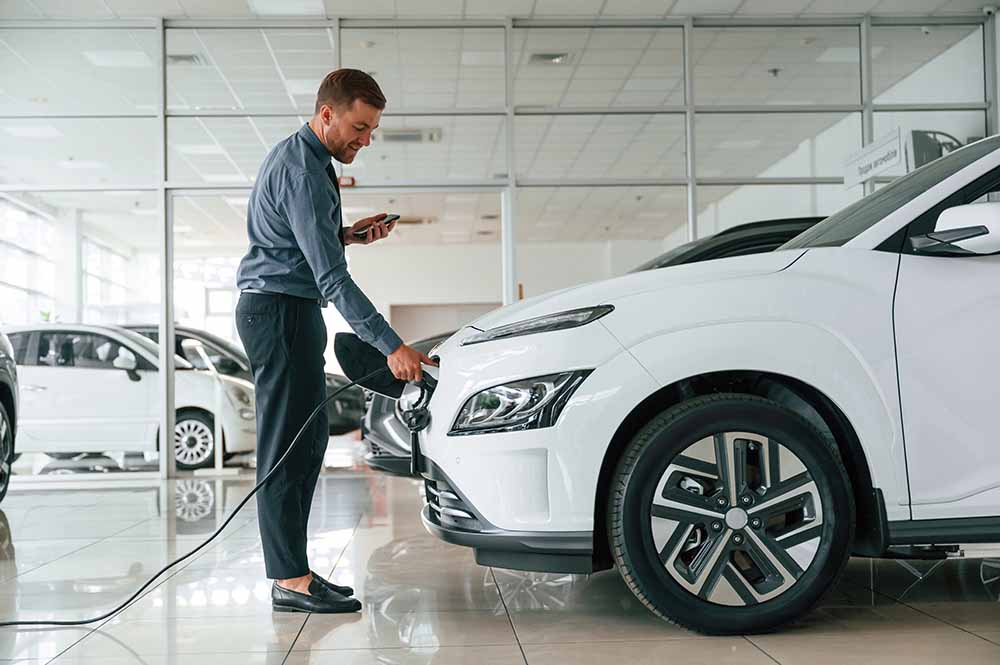
Shopping for an electric car can be simple. (Hear us out!) The truth is that electric vehicles, often just called “EVs,” are pretty similar to their fossil-fuel powered counterparts we’ve all been driving for the last century.
Instead of refuelling an EV, you simply plug it in to recharge, either at home overnight or at a public charging station, like these ones
If you’re just beginning your EV journey though, here’s what you need to consider – and what you don’t need to stress about – when shopping for a new electric car.
Shop around, call ahead Know which EVs qualify for government rebates in Canada Be realistic about your driving habits Don’t get too anxious about range anxiety Understand the different EVs: BEV versus PHEV What to expect when test-driving an EV Horsepower isn’t so important Charging speed is important Buy the EV you like
Shop around, call ahead
Call around to local dealerships a day in advance to book test drives, because EVs are selling fast these days and not every dealership will have every model in stock. (In the first quarter of 2023 alone, a record-breaking
Know which EVs qualify for government rebates in Canada
To make EVs more affordable, the federal government offers up to $5,000 in rebates on eligible vehicles through the iZEV Incentive Program. (See here for the
Be realistic about your driving habits
Driving range – the distance an EV can go before its battery is empty – varies wildly between different makes and models. Some will cover 300 kilometres, while others can do over 700 km. In general though, more driving range costs more money. So, be realistic about how much driving range you really use, and choose an EV with a range that suits your day-to-day needs. For occasional longer trips, you can always stop at a public EV charger to top-up the battery on the go.
Don’t get too anxious about range anxiety
Yes, “range anxiety” is a thing, especially for new EV drivers. It’s normal to be nervous about range and charging. The good news is that
Understand the different EVs: BEV versus PHEV
- BEV: Battery Electric Vehicle. These cars are powered purely by electricity, no gas needed. You’ll recharge them by plugging into a household outlet or public charging station.
- PHEV: Plug-in Hybrid Electric Vehicle. Power comes from a combination of fossil-fuels and electricity. You’ll plug them in to recharge, and also need to fill the gas tank occasionally.
What to expect when test-driving an EV
EVs are nearly silent, yes, and usually pretty quick too. (More on that below.) Drivers should also be aware that some EVs have a “
Horsepower isn’t so important
In the fossil-fuel days, horsepower and torque figures really mattered. They told us how speedy a car would be. The weird (great!) thing about EVs is that they’re all pretty quick, especially when accelerating from a standstill. It’s just the nature of electric motors; they deliver all their oomph almost instantaneously. So, even an EV that doesn’t have much horsepower will still feel quick in day-to-day driving.
Charging speed is important
How quickly a car’s battery can recharge is a key feature to compare when shopping for an EV. Faster charging means shorter stops at public charging stations, which can really add up on road trips. “Charging an EV can take anywhere from 30 minutes, to over 12 hours, depending on the vehicle and the type of charger. A typical EV using a Level 2 station takes around 8 hours to charge from empty, or between 40-90 minutes on a DC fast charger,”
Buy the EV you like
Remember: there’s no correct answer here. Cars are personal. And, these days, every new car is pretty good at getting from A to B. So, once you’ve crunched all the numbers and compared all the specs, buy the car you like.